Christmas Day brings final end to Barents region’s largest air polluter
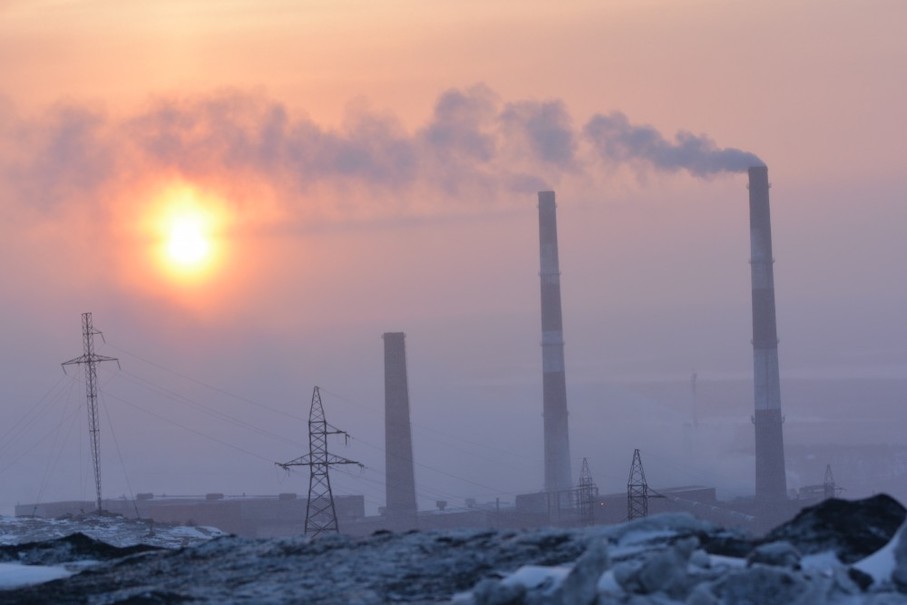
Tens of thousands of tons of sulfur dioxide and other hazardous gases from the chimneys have annually been emitted from Nornickel’s factory in the town with the same name as the metal produced.
Damage to health, environment and cross-border relations with Norway have made Nikel infamous much further away than the acid rain has damaged the fragile taiga forest on the Kola Peninsula and northern Scandinavia.
Now, it all comes to an end.
By December 25, the last workers in smelting production will be transferred to new jobs. After that, according to the company’s Director of Human Resources and Social Policy Department, Anna Krygina, the remaining workers will be with the customer service and bringing down equipment. A work scheduled to continue to the end of 2021.
Interviewed by the Nornickel-sponsored TV21, Krygina says many of the workers will retire, while many others will be employed in other vacancies with Nornickel’s subsidiary Kola Mining and Metallurgical Combine. The company operates mines in Zapolyarny while production now shutting down in Nikel will partly be transferred to the larger factory complex in Monchegorsk.
“Today we are talking about the plans for the workers. Now, the documentation and implementation of all these plans are starting. So, we still have two months of hard work,” Anna Krygina says in the interview.
It was last fall oligarch and CEO of Nornickel, Vladimir Potanin, announced the closure the smelter, a move affecting about 800 workers. With just six weeks before shutdown, only two of the workers in the smelter have not chosen any of the option offered by the company.
Nikel is a typical ‘monogorod’, a town whose economy survive purely on the basis on one major company. Many locals fear their town is doomed, but big promisses to compensate the loss of jobs are made by officials. Transmission to other businesses, like tourism, are set as a priority by both Nornickel and regional authorities. Successful or not, many of the current employees at the smelter will move. The Barents Observer has previously told the story about unsold appartments in Nikel, on the market for 100,000 rubles, or the same as an Iphone.
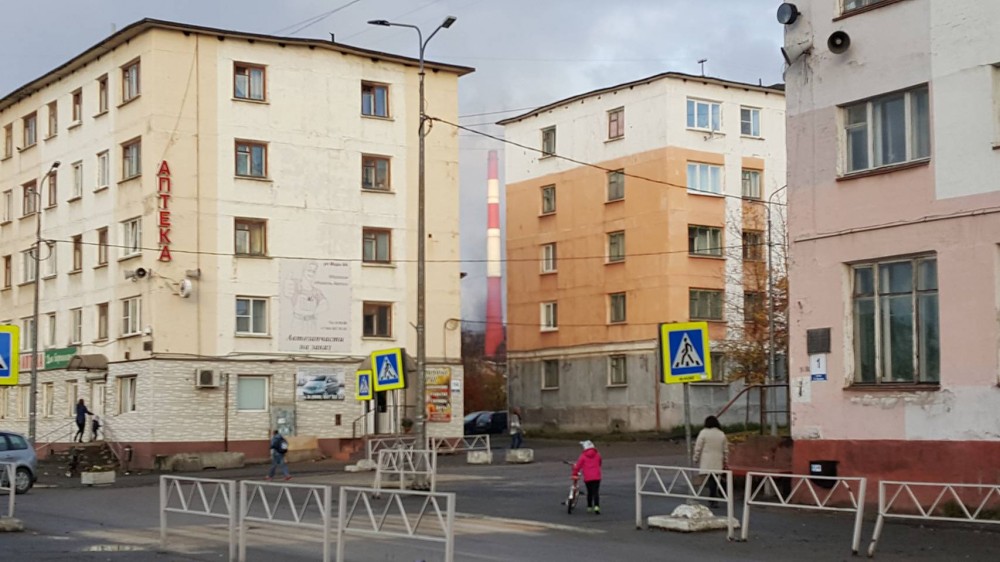
The smoke will be gone by Christmas Day, but the factory will still make the skyline of the town.
Production machinery and equipment are to be transferred to other divisions of Nornickel in the Murmansk region and on the Taimyr Peninsula in Siberia.
Buildings will be demolished by 2025. Then, a two-year period with reclamation of the land plot starts and by 2027, the smelter that was raised a few years after the Second World War will be history.

In the late 1980s and early 1990s, the smelter received ore from Norilsk which contained much more sulfur than from the local mines in Nikel and Zapolyarny. At the peak, annual emission was up to 400,000 tons of sulfur dioxide (SO2). In the last two decades, emissions are reduced to less than 90,000 tons per year. The smoke brings additional tons of heavy metals, also across the border to Norway where the maximum allowed SO2 limits for air quality notoriously have been violated.
The burning scar: Inside the destruction of Asia’s last rainforests
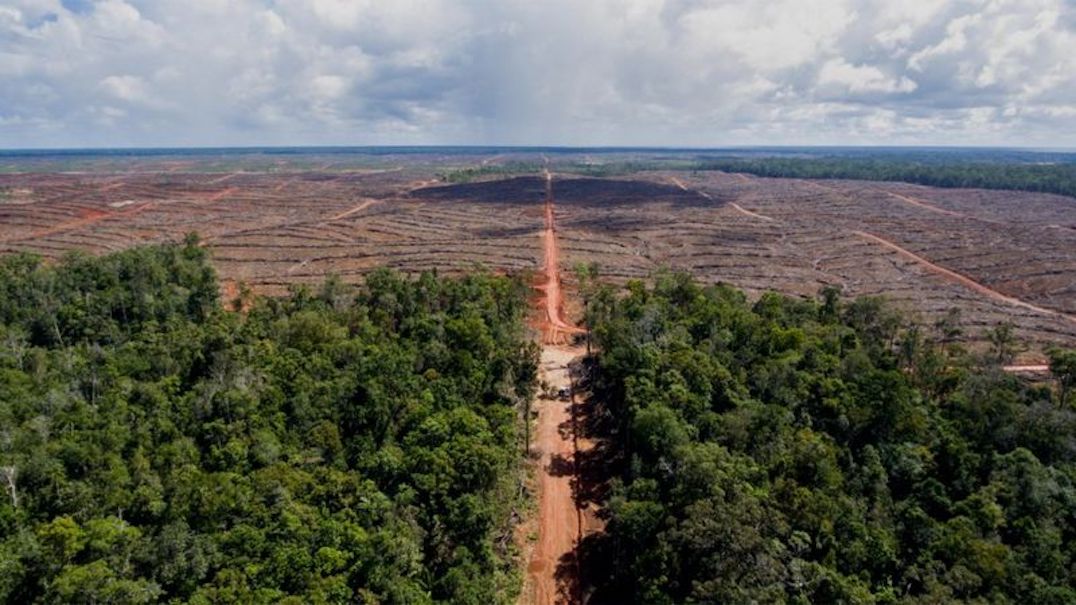
A Korean palm oil giant has been buying up swathes of Asia’s largest remaining rainforests. A visual investigation published today suggests fires have been deliberately set on the land.
Petrus Kinggo walks through the thick lowland rainforest in the Boven Digoel Regency.
“This is our mini market,” he says, smiling. “But unlike in the city, here food and medicine are free.”
Mr Kinggo is an elder in the Mandobo tribe. His ancestors have lived off these forests in Papua, Indonesia for centuries. Along with fishing and hunting, the sago starch extracted from palms growing wild here provided the community with their staple food. Their home is among the most biodiverse places on earth, and the rainforest is sacred and essential to the indigenous tribes.
Six years ago, Mr Kinggo was approached by South Korean palm oil giant Korindo, which asked him to help persuade his tribe and 10 other clans to accept just 100,000 rupiah ($8; £6) per hectare in compensation for their land. The company arrived with permits from the government and wanted a “quick transaction” with indigenous landholders, according to Mr Kinggo. And the promise of development was coupled with subtle intimidation, he said.
“The military and police came to my house, saying I had to meet with the company. They said they didn’t know what would happen to me if I didn’t.”
When he did, they made him personal promises as well, he said. As a co-ordinator, he would receive a new house with clean water and a generator, and have his children’s school fees paid.
His decision would change his community forever.

Indonesia is the world’s largest exporter of palm oil, and Papua is its newest frontier. The archipelago has experienced one of the fastest rates of deforestation in the world – vast areas of forest have been cleared to make way for row upon row of oil palm tree, growing a product found in everything from shampoo to biscuits. Indonesia’s palm oil exports were worth about $19bn (£14bn) last year, according to data from Gapki, the nation’s palm oil association.
The rich forests in the remote province of Papua had until recently escaped relatively untouched, but the government is now rapidly opening the area to investors, vowing to bring prosperity to one of the poorest regions in the country. Korindo controls more land in Papua than any other conglomerate. The company has cleared nearly 60,000 hectares of forests inside its government-granted concessions – an area the size of Chicago or Seoul – and the company’s vast plantation there is protected by state security forces.
Companies like Korindo have to clear the land in these concessions to allow them to replant new palms. Using fire to do that – the so-called “slash and burn” technique – is illegal in Indonesia due to the air pollution it causes and the high risk blazes will get out of control.
Korindo denies setting fires, saying it follows the law. A 2018 report by the leading global green timber certification body – the Forest Stewardship Council (FSC), of which Korindo is a member – concluded there was no evidence that illegal and deliberate fires were set by the company.
But according to a new investigation by the Forensic Architecture group at Goldsmiths University in London and Greenpeace International, published in conjunction with the BBC, there is evidence that indicates deliberate burning on the land during the land-clearing period. The investigation found evidence of fires on one of Korindo’s concessions over a period of years in patterns consistent with deliberate use.
Forensic Architecture uses spatial and architectural analysis and advanced modelling and research techniques to investigate human rights violations and environmental destruction. “This is a robust technique that can with a high level of certainty determine if a fire is intentional or not,” said senior researcher Samaneh Moafi. “This allows us to hold the large corporations – who have been setting fires systematically for years now – liable in the court,” she said.
The group used satellite imagery to study the pattern of land clearing inside a Korindo concession called PT Dongin Prabhawa. They used the imagery to study the so-called “normalised burn ratio”, comparing it to hotspot data in the same area – intense heat sources picked up Nasa satellites, and put the two datasets together over the same period of time, 2011 to 2016.
“We found that the pattern, the direction and the speed with which fires had moved matched perfectly with the pattern, the speed, direction with which land clearing happened. This suggests that the fires were set intentionally,” Samaneh Moafi said.
“If the fires were set from outside the concession or due to weather conditions, they would have moved with a different directionality. But in the cases that we were looking at there was a very clear directionality,” she said.
https://emp.bbc.com/emp/SMPj/2.36.3/iframe.htmlmedia captionWatch how the Forensic Architecture Group established what was happening in Papua
Korindo turned down several BBC interview requests, but the company said in a statement that all land clearing was carried out with heavy machinery rather than fires.
It said there were many natural fires in the region due to extreme dryness, and claimed that any fires in its concessions had been started by “villagers hunting giant wild rats hiding under stacks of wood”.
But locals near the concession in Papua told the BBC the company had set fires on the concessions over a period of years, during a timeframe which matched the findings of the visual investigation.
Sefnat Mahuze, a local farmer, said he saw Korindo employees collecting leftover wood, “the worthless stuff”.
“They piled up long rows, maybe 100-200 metres long, and then they poured petrol over it and then lit them,” he said.
Another villager, Esau Kamuyen, said the smoke from the fires “closed the world around them, shutting off the sky”.
According to Greenpeace International, companies are rarely held to account for slash and burn – a practice that almost every year creates a smoky haze in Indonesia which can end up blanketing the entire South East Asian region, causing airports and schools to close.
A Harvard University study estimated that the worst fires in decades in 2015 were linked to more than 90,000 early deaths. The fires that year are also believed to have produced more carbon emissions in just a few months than the entire United States economy.

Many of the tribal allegations against Korindo were investigated for two years by the Forest Stewardship Council. The regulator’s tree logo – found on paper products throughout the UK and Europe – is meant to tell consumers the product is sourced from ethnically and sustainable companies. The FSC report into allegations against Korindo was never published, after legal threats from the company, but the BBC obtained a copy.
The report found “evidence beyond reasonable doubt” that Korindo’s palm oil operation destroyed 30,000 hectares of high conservation forest in breach of FSC regulations; that Korindo was, “on the balance of probability … supporting the violation of traditional and human rights for its own benefit”; and was “directly benefitting from the military presence to gain an unfair economic advantage” by “providing unfair compensation rates to communities”.
“There was no doubt that Korindo had been in violation of our rules. That was very clear,” Kim Carstensen, the FSC’s executive director, told the BBC at the group’s headquarters in Germany.
The report recommended unequivocally that Korindo be expelled from the body. But the recommendation was rejected by the FSC board – a move environmental groups say undermined the credibility of the organisation. A letter sent to the FSC board in August, signed by 19 local environmental groups, said the groups could no long rely on the body “to be a useful certification tool to promote forest conservation and respect for community rights and livelihoods”.
Mr Carstensen, the executive director, defended the decision to allow Korindo to stay. “These things have happened, right? Is the best thing to do to say they were in breach of our values so we’re not going to have anything to do with you anymore?” he said.
“The logic of the board has been, ‘We want to see the improvements happen’.”
Korindo strongly denied that the company was involved in any human rights violations but acknowledged there was room for improvements and said it was implementing new grievance procedures.
It said it had paid fair compensation to tribes and that it had paid an additional $8 per hectare for the loss of trees – a sum decided by the Indonesian government, which granted them the concession. The BBC tried to confirm the figure with the Indonesian government, but officials declined to comment on Korindo.
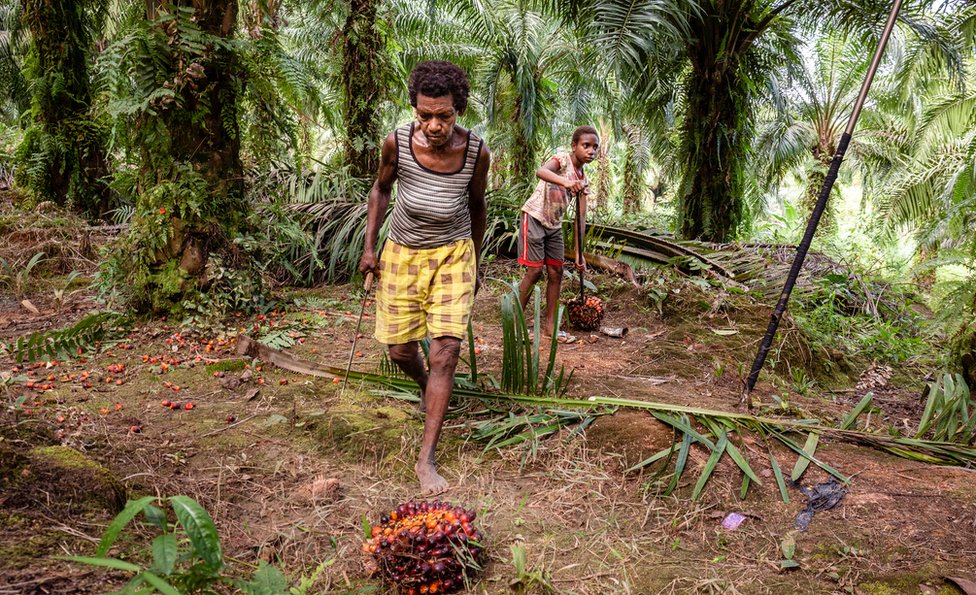
The Indonesian government maintains generally that Papua is an integral part of the nation, recognised by the international community. The province, which is half of the island of New Guinea (the other half belongs to the country of Papua New Guinea), became part of Indonesia after a controversial referendum overseen by the UN in 1969, in which just 1,063 tribal elders were selected to vote.
Since then, control over Papua’s rich natural resources has become a flashpoint in a long-running, low-level separatist conflict. Papuan activists call the 1969 referendum the “act of no choice”.
The Indonesian military has been accused by activist groups of gross human rights abuses in its attempts to suppress dissent in Papua and protect business interests there. Foreign observers are rarely granted access, “because there is something that the state wants to hide”, according to Andreas Harsono, an Indonesian researcher with the US-based Human Rights Watch.
“They are hiding human rights abuses, environmental degradation, deforestation,” he said. “And the marginalisation of indigenous people – economically, socially and politically.”
In an attempt to ease tensions, Papua was granted greater autonomy in 2001, and there has been a significant increase in government funds for the region, with Jakarta vowing to bring prosperity to the people of Papua and saying it is committed to resolving past rights abuses.
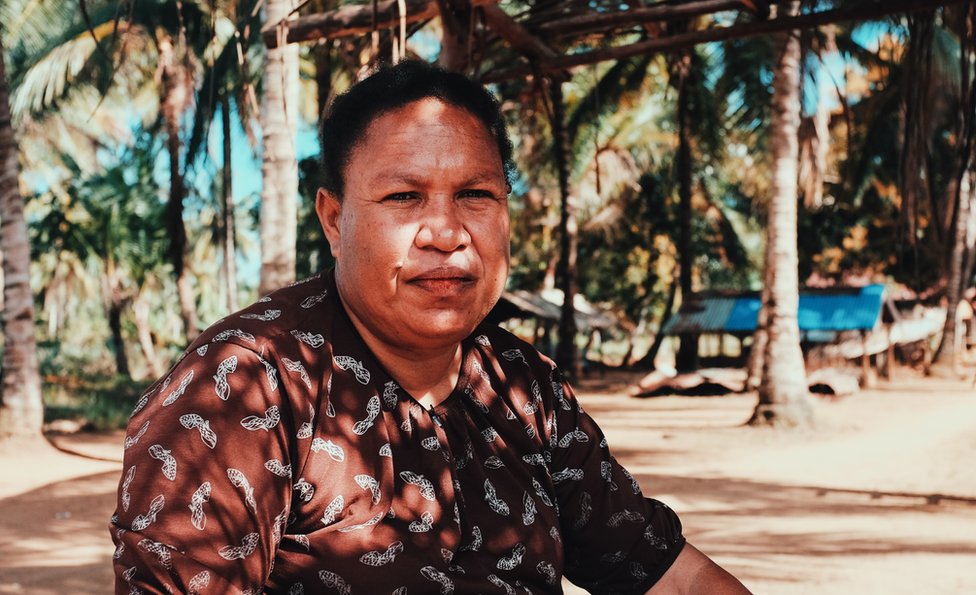
Derek Ndiwaen was one of those in the Mandobo tribe who, like Petrus Kinggo, took money from Korindo for their land. Derek’s sister Elisabeth was away at the time, working in the city, and she didn’t find out about the deal until she returned home. According to Elisabeth, Derek became embroiled in conflict with other tribes over the land deals. She believes the stress played a role in his death.
“My brother would never have sold his pride or forest before,” she said, through tears. “The company didn’t bring prosperity. What they did was create conflict, and my brother was the victim.”
Elisabeth said that her brother was also made promises of free schooling for his children and health care for the family – promises she said were never realised.
“The forest is gone and we are living in poverty,” she said. “After our forest has been sold you would think we would be living a good life. But here in 2020 we are not.”
According to Elisabeth, Korindo told the community it would build good roads and provide clean water.
But residents in her village of Nakias, in the Ngguti district say life hadn’t changed the way they hoped. There’s no clean running water or electricity in the village. Those that can afford it use generators but fuel costs four times as much as in the capital Jakarta.
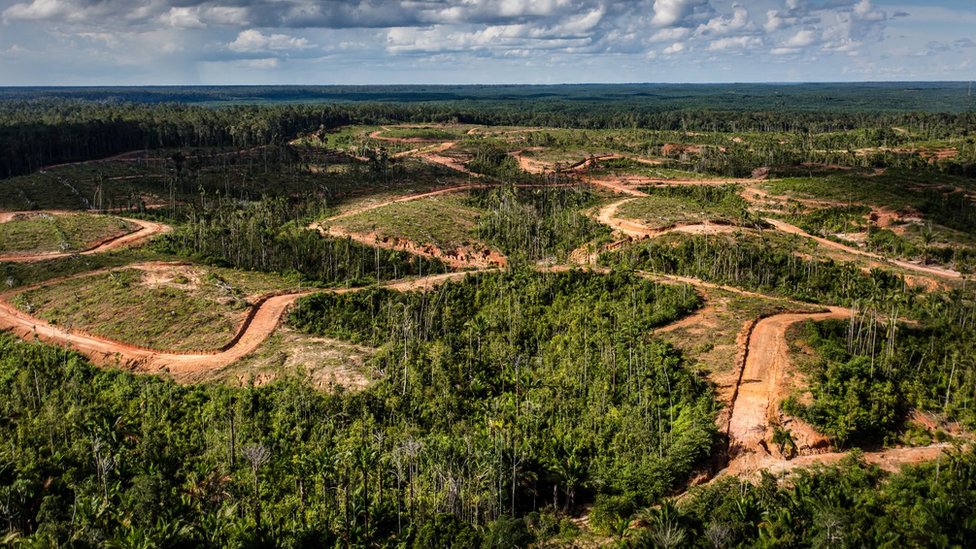
Korindo said that the company directly employs more than 10,000 people and has put $14m (£11m) into social projects in Papua, including food programmes for malnourished children and scholarships.
The company has stopped all further clearing until an assessment of high conservation and high carbon stock forests inside their concessions is carried out.
“The bigger question of what to do with the sins of the past will take a bit of time,” said Kim Carstensen, the FSC chairman. “Whether it’s two years, three years – that I don’t know.”
Elisabeth fears that nothing will make up for the destruction of the rainforest.
“When I see that our ancestral forest is all cleared, chopped down, it’s heart-breaking,” she said. “It should have been passed on to the next generation.”
“I walk through the plantation crying, and ask myself, where are our ancestors’ spirits now that our forest has been completely destroyed. And it happened under my watch.”
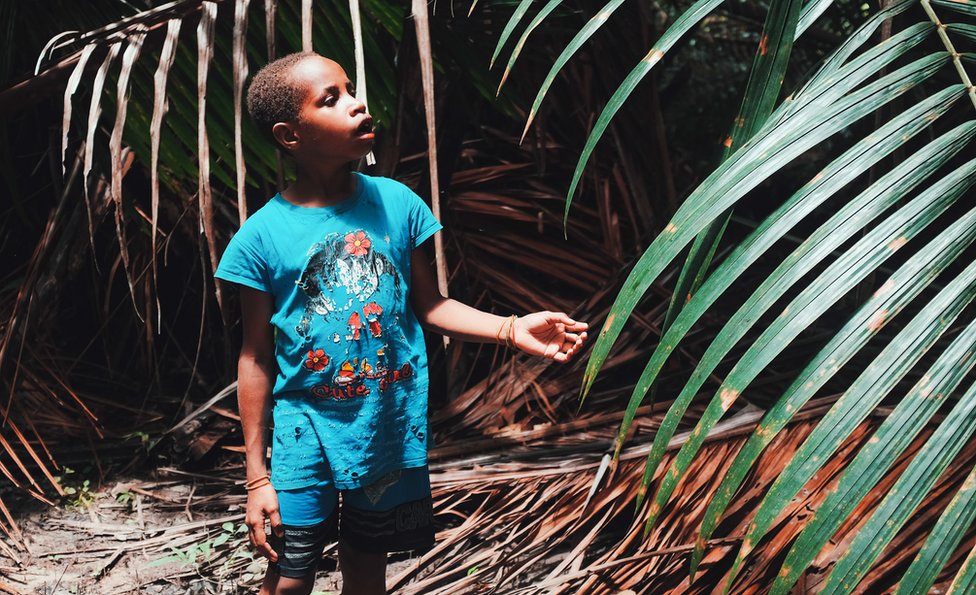
Petrus Kinggo did receive money from Korindo, he said – about $42,000 (£32,000), equal to 17 years’ pay on the provincial monthly minimum wage. And the company paid for one of his eight children’s school fees until 2017. He said he did not receive a house or a generator, and the money is all gone.
“I have nothing left,” he said. “Uncles, nephews, in-laws, grandchildren, brothers, sisters all took some. And then I spent what was left on my own children’s education.”
Thousands of hectares of the Mandobo tribe’s once vast rainforest has been logged and replaced with neat rows of oil palm trees. A further 19,000 hectares now inside a Korindo concession is earmarked for clearing.
Mr Kinggo is fighting to save some of what’s left. He fears future generations will have to “live off money” rather than the forest. He blames the government for not consulting with the villagers before giving the concession to Korindo and “sending them here to pressure us”.
But when he walks through the forest now, he looks inside, and the money he took weighs on him.
“According to God I have sinned, I deceived 10 tribes,” he said.
“The company said, ‘Thank you Petrus for looking after us so well’. But in my heart I knew I had done wrong.”
Record number of Native American women elected to Congress
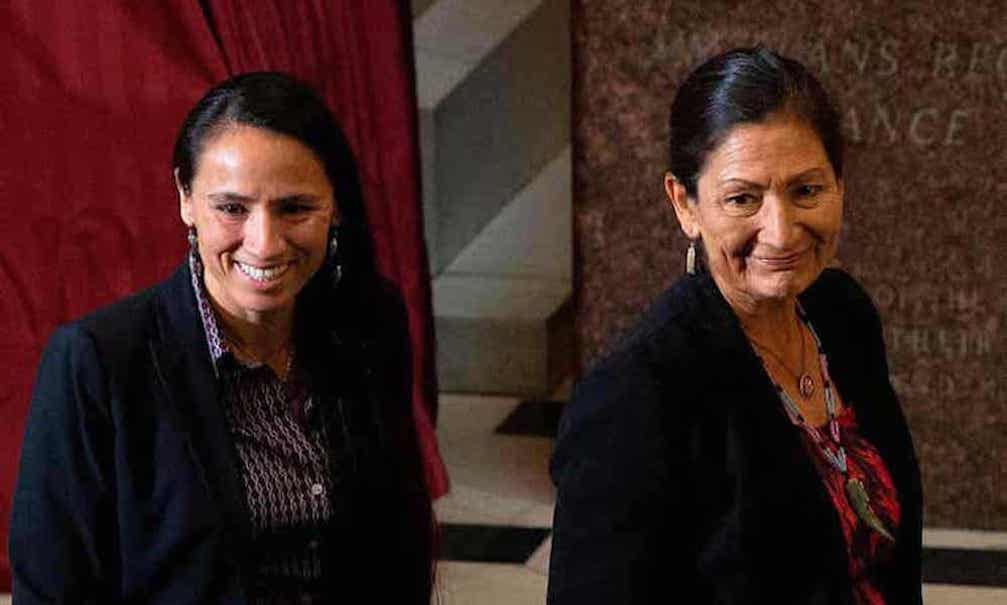
Democrats Deb Haaland and Sharice Davids retain their House seats and are joined by Republican Yvette Herrell
The 117th Congress will have a record number of Native American women after voters elected three to the House of Representatives.
Democrats Deb Haaland, a Laguna Pueblo member representing New Mexico, and Sharice Davids, a Ho-Chunk Nation member representing Kansas, both retained their seats after becoming the first Native American women elected to Congress, in 2018.
They are joined by Yvette Herrell, who is Cherokee. Herrell, a Republican, beat the Democratic incumbent Xochitl Torres Small for her New Mexico congressional seat.
The wins for Herrell and Haaland mean that New Mexico will be the first state to have two indigenous women as congressional delegates. The state also became the first to elect women of color as all three of its delegates in the US House of Representatives.
According to a Center for American Women and Politics (CAWP) report, 18 indigenous women were running for congressional seats this year – a record in a single year. Native American women made up 2.6% of all women running for Congress this year, the highest percentage since CAWP started collecting data in 2004.
There have been four Native Americans in the US Senate and a handful of indigenous US representatives. All were men until Haaland and Davids were elected in 2018.
In Kansas, Stephanie Byers, who is Chickasaw and a retired teacher, became the state’s first transgender lawmaker when she won her race for a seat in its house of representatives.
“We’ve made history here,” Byers said on Tuesday. “We’ve done something in Kansas most people thought would never happen, and we did it with really no pushback, by just focusing on the issues.”
Also in Kansas, Christina Haswood, a Navajo Nation member, became the youngest person in the state legislature at 26. A third member of the Kansas house , Ponka-We Victors, a Tohono O’odham and Ponca member, won her re-election campaign.
The US House of Representatives will have its highest number of indigenous representatives after Tuesday’s election, according to the independent Native American newspaper Indian Country Today.
Six candidates, including Haaland, Davids and Herrell, won their elections. Two Oklahoma representatives, Tom Cole, who is Chickasaw, and Markwayne Mullin, who is Cherokee, won their re-elections, and Kaiali’i “Kai” Kahele, who is Native Hawaiian, won an open seat for Hawaii. There were previously four indigenous members of Congress, all in the House of Representatives.
BUILDING BACK BETTER
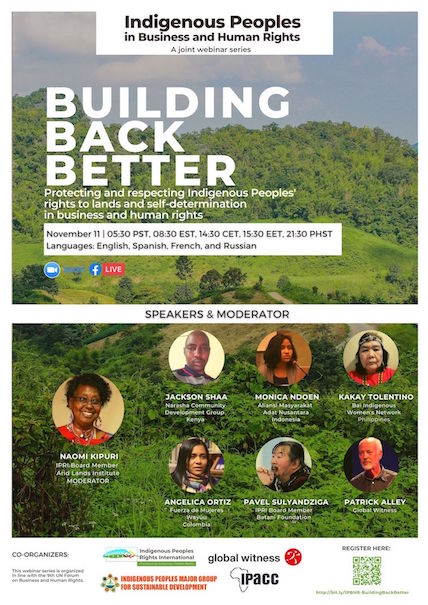
Register here: http://bit.ly/IPBHR-BuildingBackBetter
Download: IP and LTR_Concept Note-ENG.pdf (3000 KB)
Date and time:
11 November 2020
5.30 PST; 8.30 EST; 15.30 EET; 21.30 PHST
Duration: 1 hour and 30 minutes
Language interpretation: Spanish, French, English, Russian
BACKGROUND AND OBJECTIVES
Almost nine months since COVID-19 swept the world, its impacts have proven to go beyond a health crisis. Among others, the threat of a global economic crisis is already manifesting itself. Human rights and environmental organisations have called for governments and businesses to “build back better” an economic system that will depart from the unsustainable and inequitable “business-as-usual” approach, which too often leads to violation of indigenous peoples’ rights to their lands, territories and resources, including their free, prior and informed consent (FPIC). But several governments have recently been fast-tracking bills as stimulus to the economic downturn that see rollbacks in environmental and human rights standards. Among them are Indonesia’s Omnibus Bill, Canada’s Quebec Bill 61 and Ontario’s Bill 197 also known as Covid-19 Economic Recovery Act, and India’s directive to open commercial mining to national and overseas private investors. All these bills are particularly worrying for indigenous peoples as most of them pose threats to indigenous peoples’ rights to FPIC and are primarily rested on exploitation of lands and natural resources, which are often within indigenous territories.
Also, the measures to manage the pandemic, particularly restrictions on mobility and public gathering, have been taken advantage of by governments to impose and implement oppressive laws and policies. Often, these directives have been more effective in curbing the rights to freedom of expression, assembly and privacy, than the spread of the virus. Similarly, some companies, with State support, have taken the opportunity of the restrictions on mobility to expand land areas under their control through land grabbing and violent displacement. This has led to increased incidents of criminalisation and attacks on indigenous peoples at the time of COVID-19. Indigenous Peoples Rights International (IPRI) have documented, from January to July 2020, 83 incidents of killing and hundreds of human rights violations on indigenous peoples, including their collective rights to their lands, territories and resources.
In this context, the webinar aims to:
- Provide space for indigenous leaders to present cases of criminalisation and attacks against indigenous peoples involving business corporations operating in their countries;
- Discuss strategies to address the current issues of criminalisation and attacks against indigenous peoples using the UNGP’s framework, particularly highlighting the issue of access to justice;
- Provide recommendations on how to prevent violations of the rights of indigenous peoples in business operations.
SPEAKERS and MODERATOR
ANGELICA ORTIZ
SECRETARY GENERAL, FUERZA DE MUJERES WAYÚU (WAYÚU WOMEN’S FORCE) | COLOMBIA
JACKSON SHAA
SECRETARY GENERAL, NARASHA COMMUNITY DEVELOPMENT GROUP | KENYA
Jackson M. Shaa is the Executive Director Narasha Community Development Group and Principal Enariboo Primary School in Kenya. He has led NCDG to defend the rights of indigenous people in Naivasha Kenya, having represented the organization in engaging with the national and county governments, the international financial institutions and National and international civil society forums. He took part in a number of research on indigenous people and geothermal exploration in Kenya, impact of climate change and it’s impacts. On academic, he hold a masters of education from the University of Nairobi. He participated in indigenous law training at the University of Pretoria in South Africa.
KAKAY TOLENTINO
NATIONAL COORDINATOR , BAI INDIGENOUS WOMEN’S NETWORK | PHILIPPINES
Kakay Tolentino is an indigenous Dumagat woman of Sierra Madre, the longest mountain range in the Philippines. She has been doing community organising with her community and other indigenous communities in the Philippines since the 1980s. She is currently the national coordinator of Bai Indigenous Women’s Network, which is composed of 11 local indigenous women organizations. She is also the spokesperson of the No to Kaliwa-Kanan-Laiban Dam Network. She was the acting Secretary-General of the KATRIBU Partylist from 2011-2013 and is now a member of the National Council of Leaders of KATRIBU, the National Alliance of Indigenous Peoples organization in the Philippines.
MONICA NDOEN
POLICY DEVELOPMENT AND ADVOCACY OFFICER, ALIANSI MASYARAKAT ADAT NUSANTARA | INDONESIA
Monica Ndoen works as Policy Development and Human Rights Protection Officer with Indigenous Peoples Alliance of the Archipelago (AMAN), a national organisation that represents 2,332 indigenous communities throughout Indonesia, amounting to about 17 million individual members.
PATRICK ALLEY
INTERNATIONAL ADVISORY GROUP MEMBER, INDIGENOUS PEOPLES RIGHTS INTERNATIONAL
DIRECTOR AND CO-FOUNDER, GLOBAL WITNESS
Patrick co-founded Global Witness in 1995. Since then Global Witness has become a global leader in its field, described by Aryeh Neier, former President of the Open Society Foundations, thus: “Global Witness brings together the issues of human rights, corruption, the trade in natural resources, the role of banks, the arms trade, conflict. It is the only organisation that does this. Period.”Patrick has taken part in over fifty field investigations in South East Asia, Africa and Europe and in subsequent advocacy activities. Patrick conceived several of Global Witness’ campaigns and focuses on corruption, conflict resources, forests and land, and environmental defenders. He is a board director of Global Witness and is involved in the organisation’s strategic leadership.Alongside his two co-founders, Patrick received the 2014 Skoll Award for Social Entrepreneurship.Patrick is also a trustee of the OpenCorporates Trust Limited.
PAVEL SULYANDZIGA
BOARD MEMBER, INDIGENOUS PEOPLES RIGHTS INTERNATIONAL
FORMER MEMBER OF THE WORKING GROUP ON BUSINESS AND HUMAN RIGHTS
Pavel Sulyandziga (PhD in Economics) is Chairperson of the Board of the International Development Fund of Indigenous Peoples in Russia (BATANI) and is currently a Visiting Scholar at Dartmouth College (US). He was a member of the Civic Chamber of the Russian Federation (2006 – 2014) and advisor to the president of RAIPON (Russian Association of Indigenous Peoples of the North, Siberia and the Far East). At the beginning of his career he was a school teacher of mathematics in Primorskiy kray, Russia (1984-1987). In 1991 he was elected as Chairman of the Indigenous Peoples Association of the Primorskiy kray. His international activity included participating in the Eurasian Club (Japan) on assistance to the education and preservation of culture of indigenous peoples (1991-1993); and visiting Indian reservations in the USA (California, Oregon, Washington) to study their experience on education, culture and self-governance (1993). From 1993 to 1994, Mr. Sulyandziga participated in the elaboration of a project on the preservation of biodiversity in the Bikin river valley, where he was responsible for project implementation. In 1994-1995 he participated in the project «Traditional Indigenous Crafts» funded by the Eurasian Club (Japan); he was Indigenous curator of the cooperative project on the preservation of the Ussuri Tiger; and in 1997-2000 he was coordinator of the Danish-Greenlandic Initiative for assistance to indigenous peoples of Russia. In addition, Mr. Sulyandziga was a councilor to the Governor of the Primorskiy kray on indigenous issues (1994-1997). In 1997 he was elected Vice-president and then in 2001 First Vice-president of RAIPON. From 2005 to 2010 he was a member of the United Nations Permanent Forum on Indigenous Issues.
NAOMI KIPURI (MODERATOR)
BOARD MEMBER, INDIGENOUS PEOPLES RIGHTS INTERNATIONAL
EXECUTIVE DIRECTOR, ARID LANDS INSTITUTE
Naomi is the chairperson of the Task Force involved in County/community issues relating to documentation of historical and cultural institutions and other significant matters including establishment of a museum and cultural centre for the County Government of Kajiado. She is the founder of Arid Lands Institute concerned with promoting sustainable utilization of land, raising awareness on environmental protection and conservation and promoting resource tenure security; advocating for human rights of underserved indigenous communities; raising awareness and support gender equity in access, control and ownership of productive resources; and encouraging and promoting production and documentation of historical, cultural and human interest material of historical significance.
Organisers:
Indigenous Peoples Rights International (IPRI), Global Witness, Indigenous Peoples of Africa Coordinating Committee (IPACC) and Indigenous Peoples Major Group (IPMG) for Sustainable Development
EXPLORING THE ARCTIC OCEAN: THE AGREEMENT THAT PROTECTS AN UNKNOWN ECOSYSTEM
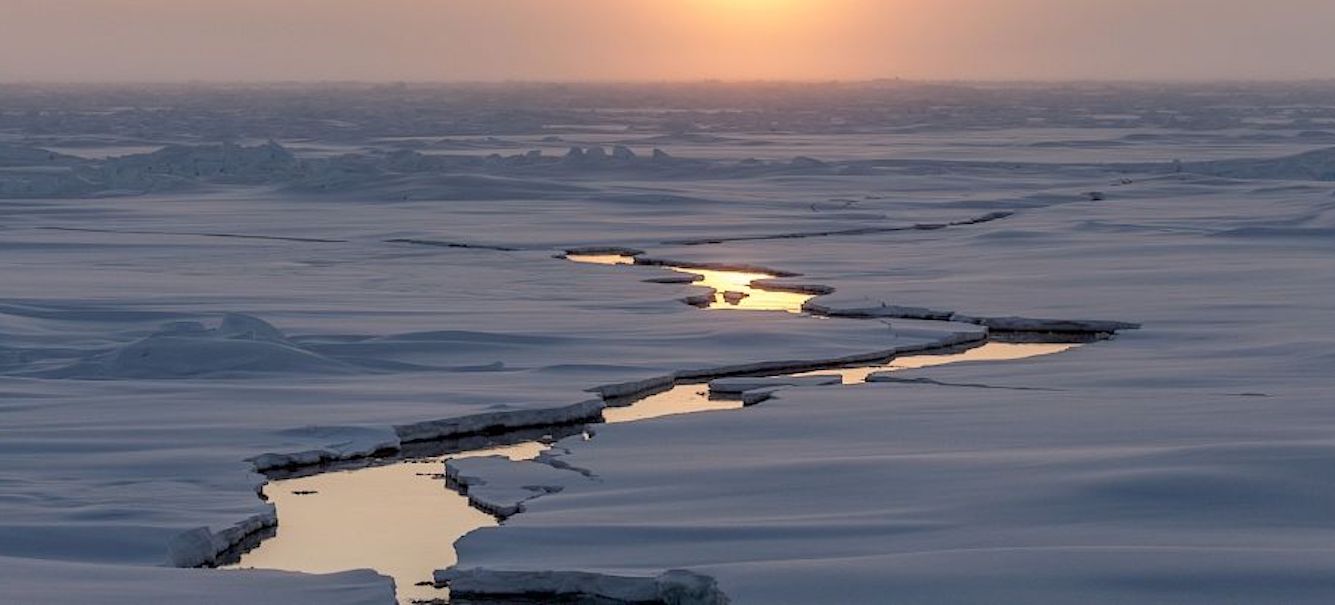
A thick layer of multiyear sea ice once completely covered the central Arctic Ocean. But as the ice continues to retreat, waters that were previously only accessible to heavy icebreakers could soon open up and attract commercial fishing vessels. Yet, little is known about the ecosystem emerging below the ice and unregulated fishing could have detrimental impacts.
This was a concern to the Arctic coastal states. Thus, they decided to prevent commercial fishing until better scientific knowledge was available and to engage other states with distant-water fishing capacity as well. The result was the International Agreement to Prevent Unregulated Fishing in the High Seas of the Central Arctic Ocean, signed in 2018 by Canada, Iceland, the Kingdom of Denmark, Norway, the United States and the Russian Federation, as well as China, Japan, South Korea and the European Union.
We asked Maya Gold for an introduction to the milestone agreement. Maya Gold is a Senior Advisor within International and Intergovernmental Affairs at Fisheries and Oceans Canada and Canada’s Head of Delegation to our Protection of the Arctic Marine Environment (PAME) Working Group.

IN BRIEF, COULD YOU EXPLAIN WHAT THE INTERNATIONAL AGREEMENT TO PREVENT UNREGULATED FISHING IN THE HIGH SEAS OF THE CENTRAL ARCTIC OCEAN IS?
The legally binding Agreement to Prevent Unregulated High Seas Fisheries in the Central Arctic Ocean was signed in Ilulissat, Greenland on October 3rd, 2018. Once it enters into force, the agreement will commit the parties to not authorize any vessel flying its flag to engage in commercial fishing in the high seas portion of the central Arctic Ocean. The agreement will be in place for up to sixteen years, renewable in increments of five years.
This agreement provides a framework for the parties to cooperate to better understand the ecosystems in and adjacent to the central Arctic Ocean. It prevents commercial fishing from occurring until adequate scientific information is available to inform decision making in relation to the viability and sustainability of any potential future fishing activities in the agreement area. Parties intend to meet at least every two years to review implementation progress and the scientific information developed through a joint program of scientific research and monitoring.
To bring the area into perspective: The central Arctic Ocean is the largest area of high seas in the Arctic , it is surrounded entirely by the exclusive economic zones (EEZs) of Canada, the Kingdom of Denmark (in respect of Greenland and the Faroe Islands), Norway, the Russian Federation, and the United States, and spans an area of approximately 2.8 million square kilometers – virtually the same size as the Mediterranean Sea.
WHY WAS THERE A NEED FOR SUCH AN AGREEMENT?
Under the provisions of the 1982 United Nations Convention on the Law of the Sea (UNCLOS), coastal states can exercise jurisdiction over fisheries zones extending 200 nautical miles seaward from coastal baselines. In some instances, the EEZs of adjacent and/or opposite states are geographically positioned such that they totally enclose an area of the “high seas” outside their fisheries jurisdiction. However, despite being entirely surrounded by the EEZ’s of states, vessels from any state in principle have the right to fish in these high seas areas, unless they have entered into an international agreement specifying otherwise.
The central Arctic Ocean has historically been an area completely covered with multiyear sea ice and inaccessible except to heavy icebreakers. With climate change, the ice in this area has been rapidly disappearing, with most recent studies indicating the area could be completely free of ice in the coming years, some predictions as early as 2030. In fact, there are now parts of the high seas in the central Arctic Ocean which are already free of ice and accessible to vessels in the summer months. With the reduction of ice in the Arctic Ocean, it is now feasible that fishing vessels could enter the central Arctic Ocean and fish. The lack of scientific knowledge about the marine ecosystem and the species found in the Arctic Ocean means that such a scenario could be catastrophic. For the duration of this agreement, such a scenario will be prevented, since the main objective of this agreement is to prevent commercial fishing from occurring in the near term until better scientific knowledge could be gained about the ecosystem.
HOW DOES IT TIE INTO OTHER INTERNATIONAL AGREEMENTS FOR THE ARCTIC OCEAN?
The three other international legally binding agreements which are specific to the Arctic and were negotiated under the auspices of the Arctic Council are the Agreement on Cooperation on Aeronautical and Maritime Search and Rescue in the Arctic, the Agreement on Cooperation on Marine Oil Pollution Preparedness and Response in the Arctic, and the Agreement on Enhancing International Arctic Scientific Cooperation.
Given the operational nature of those agreements, there is in fact no substantial overlap between those agreements and the central Arctic Ocean fisheries agreement. Although by name you would expect the scientific cooperation agreement to be relevant, that agreement is rather about the movement of people and equipment for scientific purposes between the Arctic States, and would not be relevant for a science program in the high seas of the central Arctic Ocean, which is governed by the freedom of marine scientific research under UNCLOS.
A notable difference between the these three agreements negotiated under the auspices of the Arctic Council and the central Arctic Ocean fisheries agreement is the membership. The fisheries agreement signatories do not mirror the Arctic Council’s membership, rather it consists of Canada, the Kingdom of Denmark, Norway, the Russian Federation, the United States, Iceland, China, Japan, Korea and the European Union.
WHEN AND BY WHOM WAS IT INITIATED?
In 2010, the United States effectively closed its EEZ North of Alaska to commercial fishing. Canada followed suit in 2014 with the “Beaufort Sea Fish Management Framework”, which was a partnership between the Fisheries and Oceans Canada, the Inuvialuit Regional Corporation, the Inuvialuit Game Council and the Fisheries Joint Management Committee. It determined: “Potential commercial fisheries will only be considered in light of scientifically supportable estimates of surplus and sustainable stocks” (Fisheries and Oceans Canada 2009).
Following several rounds of bilateral discussions, in February 2014 Canada, the Kingdom of Denmark, Norway, the Russian Federation and the United States issued the “Nuuk Statement” calling for action on the central Arctic Ocean issue. These same states signed the non-binding “Oslo Declaration” the following year, in which they agreed not to allow their commercial fleets to fish in the central Arctic Ocean until there would be sound scientific base and an appropriate management regime in place (Norway 2015). The Oslo Declaration also recognized that other nations/jurisdictions with the distant-water fishing capacity needed to be engaged on this issue.
In December 2015, negotiations began among the five states that signed the Oslo Declaration as well as China, the European Union (which has competence over fisheries policy on behalf of its member states), Iceland, Japan and the Republic of Korea. David Balton, with the US State Department, was the Chair of the negotiation process and it was the US who initiated the discussions among the coastal states, which resulted in the Oslo declaration.
WHO ARE THE SIGNATORIES?
- Canada
- Iceland
- The Kingdom of Denmark (in respect of Greenland and the Faroe Islands)
- Norway
- The Russian Federation
- The United States of America
- China
- Japan
- South Korea
- The European Union
WHAT IS THE CURRENT STATUS OF THE AGREEMENT AND WHEN WILL IT ENTERED INTO FORCE?
As of August 2020, nine of the ten signatories have completed the ratification process for the agreement. The agreement will enter into force 30 days after receipt of the tenth and final instrument of ratification (once all ten parties ratify) and will remain in effect for 16 years. It will be automatically extended for additional 5-year periods if the parties agree.
Acknowledging Indigenous land is the first step in taking better care of it
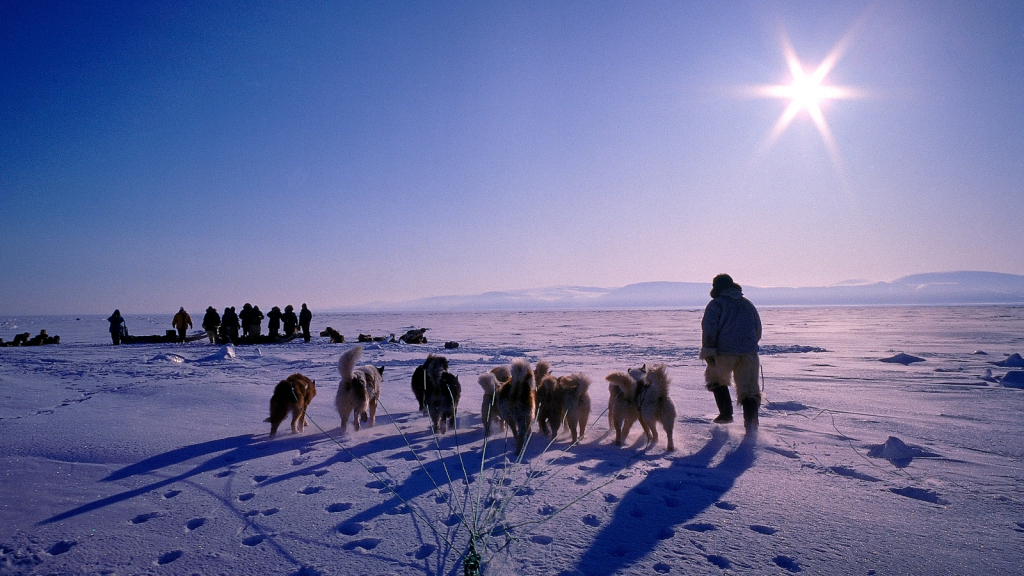
Nikoosh Carlo, Ph.D., is CEO of CNC North Consulting, which focuses on community-driven solutions to climate change, and a Public Voices Fellow of The OpEd Project and the Yale Program on Climate Change Communications.
In September, Schitt’s Creek, a sitcom created by the Canadian actor Dan Levy and his father, Eugene, won nine Emmys. Levy’s newly raised profile called attention to his efforts to learn about Indigenous culture and history in Canada with the help of a free online course at the University of Alberta. Back in August, he invited people to join him via an Instagram post that was liked by thousands.
The course is part of an effort in Canada to face an ugly history of nation building that continues to impact people today and that we must also confront in the U.S. Another piece of this effort is a formal land acknowledgement at the start of events or performances, such as the one offered at this year’s Academy Awards by the Maori director Taika Waititi.
“The academy would like to acknowledge that tonight we have gathered on the ancestral lands of the Tongva, the Tataviam and the Chumash. We acknowledge them as the first peoples of this land on which the motion picture community lives and works,” Waititi said. Likewise, the new policy platform introduced at this year’s (virtual) Democratic National Convention acknowledged “that we gather together to state our values on lands that have been stewarded through many centuries by the ancestors and descendants of Tribal Nations who have been here since time immemorial.”
A land acknowledgement highlights the ongoing stewardship by Indigenous peoples, uplifts Indigenous voices, and helps audiences and institutions reconsider their roles within a broader community. It’s a sign of respect that’s common in Canada, Australia, New Zealand, tribal nations, and increasingly in the U.S. It’s also a step toward recognizing that multiple perspectives are needed to address climate change.For a problem that is burning out of control worldwide, only cross-cultural cooperation can offer hope for the future.
Indigenous peoples’ knowledge and leadership can drive innovative climate solutions. For example, in the southwestern Alaska village of Igiugig, people are piloting sustainable microgrid projects to replace fossil fuels with wind turbines and non-dam river technology to power a community farm. At a global level, Indigenous organizations work alongside the eight nations in the Arctic Council to address sustainable development and environmental protection. One of these organizations, Gwich’in Council International, leads efforts to coordinate wildland-fire emergency response across international boundaries. For a problem that is burning out of control worldwide, only cross-cultural cooperation can offer hope for the future.
Indigenous peoples in Alaska, where there are over 200 federally recognized tribes making up approximately 15 percent of the population, have thrived in the extreme lands and waters of the Arctic for millennia.
As a child, I lived a few blocks from my grandparents, aunties, and uncles, who ensured that we harvested, ate, and shared traditional foods: salmon, moose, berries. In the blueberry patch, I heard the stories of our ancestors and learned that we are all connected in community. Indigenous peoples have a connection to the land that has made us expert observers and caretakers of the environment — a connection I feel more keenly in these pandemic times.
There’s a model for mutual respect and cooperation in traditional Alaska Native practice. It begins with how we introduce ourselves to each other — think of it as our own personal land acknowledgment:
My name is Nikoosh Carlo. I am Koyukon Athabascan, born and raised in Fairbanks and Tanana, at the confluence of the Tanana and Yukon Rivers. I am the oldest daughter of Gail and Wally Carlo from North Dakota and Tanana. My grandparents were Poldine and Bill Carlo from Nulato and Rampart, Alaska.
When others introduce themselves to me, I’m actively listening for family lineages and places so I can understand how we are connected. These introductions ground us in our history and shared values, and guide how we might work together.
Indigenous and non-Indigenous peoples are inextricably linked in the battle against climate change. We can tackle it together if we build a foundation of mutual respect. It starts with acknowledgment: of land, of history, and of Indigenous leadership. Healing the environment can also heal communities.
Nornickel is “cynical, corrupt and socially irresponsible”, says Russia’s top legislator
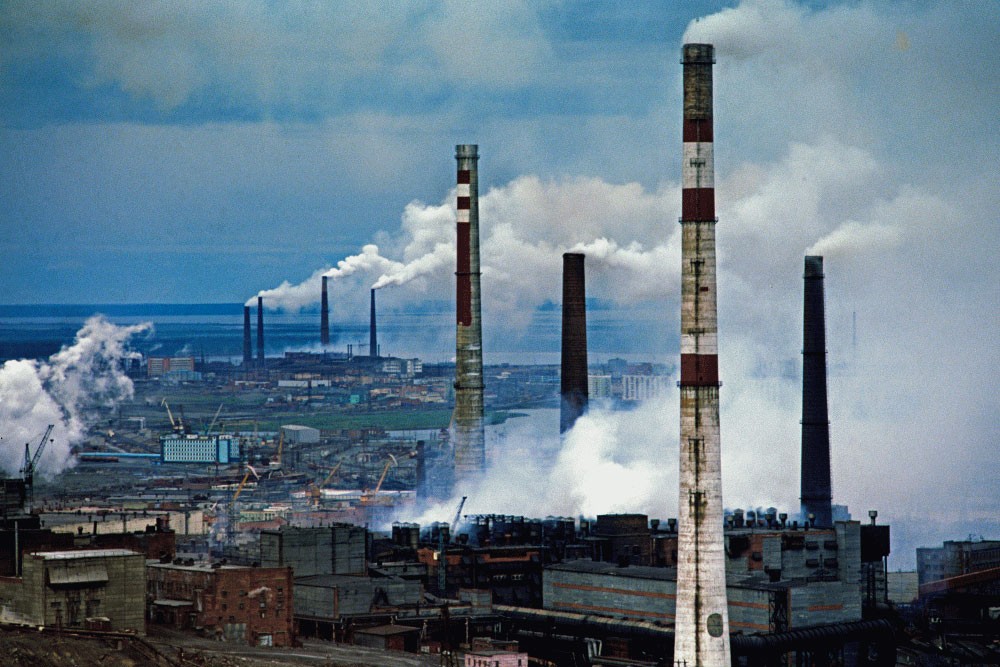
Following a parliament visit to the far northern company town of Norilsk, the Federation Council and its Speaker Valentina Matvienko expresses shock and outrage about company mismanagement and massive pollution in the Arctic.
After decades of massive ecological destruction in the Russian North, federal officials appear to have decided that time has come to slap the powerful mining and metallurgy company.
Rarely has a top Russian legislator lashed out against one of the country’s biggest companies like Valentina Matvienko did on the 21st October. In a press conference, Matvienko said that company town of Norilsk used to be a “garden town”, but now looks more like a “slum” with worn-out infrastructure, and power grids, water canalization, roads and housing in disarray.
“Cynical company”
The vocal attack of the company did not only aim at Nornickel’s recent huge spill of diesel fuel that has ruined vast areas of tundra and waterways. Matvienko pointed her finger at the company’s general practices.
According to the long-time speaker of the parliament body, Nornickel has put on display “complete cynicism” and “total indifference towards the motherland where they live and make huge money.”
This is not a socially responsible company, she stressed. “That is all PR,” she underlined.
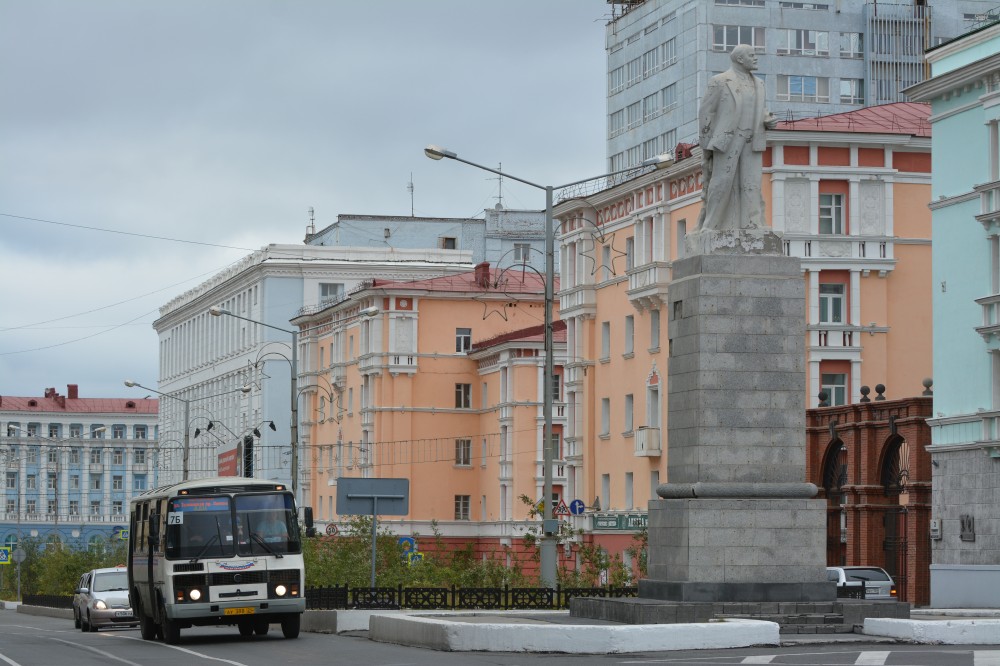
Corruption
Matvienko, who over the years has had several leading posts in Putin’s Russia, also accused the managers of Nornickel of grave corruption.
The company is bribing both local and regional legislators and have their people in control over the Norilsk town budget. Furthermore, she also points her finger at regional and state authorities indicating that they are part of corrupt practices.
“How come that the Ministry of the Far East (and Arctic), federal structures, the presidential envoy to the district, nobody — nobody really sees that the houses are falling apart and what state the town is in? Why has everyone kept quiet? Is everyone really in the pockets of Nornickel? Really? What other conclusion can be made?” Matvienko said.
Parliament action
The harsh comments come after the upper house of parliament conducted a visit to Norilsk, the remote northern town that is centerpiece in the mining and metallurgy company’s Arctic operations. Fifteen senators from five different parliament committees took part in the visit, along with representatives of several federal ministries, state agencies and law enforcement authorities, the Federation Council informs.
In an official statement issued after the visit, the legislators point at serious problems with the local social infrastructure, including housing, healthcare, schools and kindergartens.
“Modern-day Norilsk is one of the most polluted towns not only in Russia, but in the world, and the [oil spill] catastrophe has only aggravated the environmental problems and attracted attention towards them,” says Deputy Speaker Nikolay Zhuravlev.
Quick action
The Federation Council now demands that Nornickel takes quick action to deal with the problems.
“The water supply system must come in order, together with housing, kindergartens, schools and policlinics,” Chairwoman Matvienko underlines. It should not be a major problem, she argues.
“For them, to build a kindergarten or a school is like a cup of coffee, or like going twice to a restaurant,” she underlines and points at the super-wealthy main shareholders of the company.
And time is the essence. The work must be completed in 1-2 years, the legislators underline.

Kola Peninsula
According to critics, Nornickel’s mismanagement not only applies to operations in Taymyr, but also in the Kola Peninsula.
During the recent municipal elections in the Pechenga district, opposition politicians accused Nornickel of meddling in the vote and for putting its people in the municipal legislative assembly. They also argued that the company spent many million rubles on the election campaign of government-loyal party United Russia and that they are in full control over the local government.
“No more! For 20 years they have shown us their attitude to the people, they have robbed us, knitted knots around our necks and weaved a web out of which we must finally get disentangled,” the election campaigners said about their opponents.
The Pechenga district is located along the border to Norway and Finland and houses several major plants operated by Nornickel.
Vladimir Potanin
Norilsk Nickel is the world’s leading producer of nickel and has the key parts of its operations in the Taymyr Peninsula and Kola Peninsula. Over the years, the vulnerable Arctic lands surrounding the company plants have been subject to heavy pollution. In 2018, a total of 1,9 million tons of sulfur dioxide were emitted from the chimneys of Norilsk. That was by far the biggest SO2 emissions in the world.
At the same time, huge dividends have been cashed out by the company owners. In 2018, as much as $3,7 billion was distributed to the shareholders.
Majority shareholder is Vladimir Potanin. He was in 2019 ranked as Russia’s richest person and the 41st richest in the world.
THE KILLING OF SOMKHELE ENVIRONMENTAL ACTIVIST, FIKILE NTSHANGASE
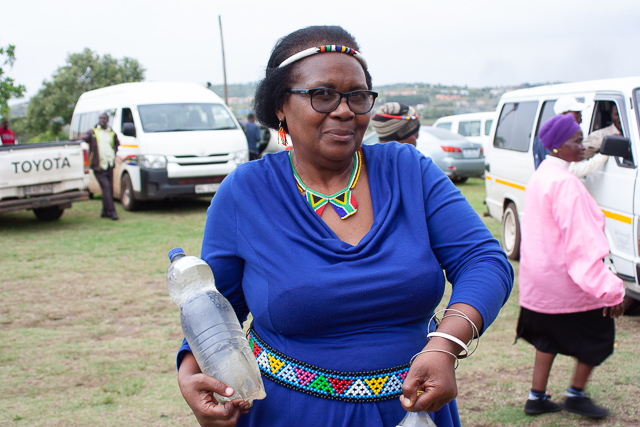
“I refused to sign. I cannot sell out my people. And if need be, I will die for my people.” Tragically, grandmother Fikile Ntshangase’s words became a reality when she was gunned down in her home at Ophondweni, near Mtubatuba, on the evening of 22 October 2020.
Mama Ntshangashe was the Vice-Chairperson of a sub-committee of the Mfolozi Community Environmental Justice Organisation (“MCEJO”). MCEJO has been challenging the further expansion of a large coal mine at Somkele in KwaZulu-Natal by Tendele Coal Mining (Pty) Ltd. One of the court cases brought by MCEJO is scheduled for hearing in the Supreme Court of Appeal on 3 November 2020.
On Thursday, 22 October 2020 at about 18:30, four gunmen arrived at Mam Nsthangase’s house, where she lives with her 11-year old grandson. Current reports say that they forced themselves into the home and shot her 5 times, and that she died on the scene.
Tendele’s coal mining operations have caused untold destruction of the environment and the homes and livelihoods of the residents of Somkhele. (Photographs and video footage available.)
Over the past few months, tension has been rising in the community over the proposed expansion of Tendele’s operations, and MCEJO’s opposition to that expansion.
Recently, Tendele was pushing for an agreement to be signed between MCEJO and Tendele to the effect that MCEJO would withdraw its Court challenges of Tendele’s expansion of its coal mine at Somkhele. Mama Nsthangase refused to sign the “agreement”, which certain of her fellow sub-committee members signed, purportedly doing so on behalf of MJECO.
She warned sub-committee members that they had no power to make decisions on behalf of MJECO and that the “agreement” only benefited Tendele. She also refused to attend any of the secret meetings that other sub-committee members held with Tendele. Days before her brutal killing, Mama Ntshangase stated her intention to write an affidavit, revealing that sub-committee members had spoken to her of a payment of R350,000 in return for her signature.
The court challenge that placed a price on Mama Ntshangase’s life is MJECO’s pending review application of Tendele’s new mining right in respect of a 222km2 area in Mpukunyoni, KZN. This review is due to be heard by the North Gauteng High Court in March 2021.
Tendele has publicly characterised MCEJO’s legal challenge as a threat to the mine’s continued existence, stating that, with the current mining area depleted, it needed to expand its mining area, or face closure.
The expansion requires relocation of 21 families (19 of them MJECO members) from their ancestral land. Many of these families have lived on their land for generations.
Tendele cannot commence any operations in the new mining right area until these families agree to Tendele’s “compensation” offer and sign relocation agreements. These families were subjected to months of violence and intimidation. Despite the clear volatility of the situation, Tendele has accused these families of “holding the Mine, its … employees and many families who have signed [relocation] agreements and indeed the entire community to ransom”. Tendele carried out its pressure campaign even while these families were receiving anonymous death-threats and gunmen opened fire on one of the families’ homes.
In May 2020, Tendele tried to bring an urgent court application to force the families to accept their compensation offer, but abruptly removed the matter from the Court roll when the families opposed the application.
Tendele has now embarked upon a campaign to pit the State, the Ingonyama Trust Board, traditional leaders and fellow community members against these families to pressure them into signing relocation agreements. Tendele requested the MEC for Transport, Community Safety & Liaison KZN, Minister Ntuli and department officials to set up a “task team”, with the aim of “the two court cases opened by MJECO against the mine remain a threat and needs [sic] to be withdrawn”. This Task Team has since described their role to include “deliberat[ing] on the court cases which pose a threat”.
It is against this backdrop that the pro-mining campaign was stepped up during the past week. On 15 October, two sub-committee members, accompanied by two known hitmen, tried to disrupt a MCEJO executive committee meeting with community leaders, which included Mama Ntshangase. One sub-committee member tried to lock the doors, and a prominent leader was assaulted. A criminal case is being opened. This leader, who works in another area, has been warned that his life will be in danger if he is seen in the vicinity.
Billy Mnqondo, a founding member of MCEJO, reports that one of the hitman kept saying “kuzochitheka igazi” (there will be bloodshed). His appeal to the police is: “Make sure that the criminals who murdered our comrade are caught and go to jail. Mam Ntshangase was killed for standing up for what is right. This is wrong and cannot go unpunished.”
It appears that the mine is being supported by the KwaZulu-Natal government. In July, the Department of Community Safety and Liaison sent a staff member, apparently from its Civilian Secretariat arm (which is conspicuous in its absence whenever the threat of violence looms), to persuade community members to negotiate with the mine.
Since then, after MCEJO members thought it only proper to approach the office of the Ingonyama King Goodwill Zwelithini about their struggle, they have come under even further government pressure via the office of the Premier and COGTA. This is the self-same government that claims to be a custodian for land reform to redress the land imbalance – while wilfully pushing to displace rural farmers from their family land from which they subsist.
For the State and Traditional Authorities actively to assist Tendele in its efforts to orchestrate a withdrawal of MJECO’s review application is abhorrent to our Constitutional order. Without access to Court, local communities’ right to dignity and section 24 environmental rights are illusory.
The strategies used by Tendele are sadly typical of many companies operating in impoverished rural communities. Mines dangle incentives to impoverished community members with the inevitable consequences of stirring deep community divisions, which almost always lead to violence and deaths. In rural areas that are difficult to police, it takes someone with the determination and the courage of Mama Ntshangase to promote community solidarity and resistance in the face of these strategies. There are other leaders of this calibre in MCEJO and, if anything, the assassination of Mama Ntshangase has renewed their determination to step up the fight against exploitation by the mine.
We mourn the senseless tragedy of Mama Ntshangase’s murder, and condemn her killing.
We call on the South African Police Service to act swiftly to arrest and prosecute her murderers.
We call on Tendele to stop its campaign of dividing and fomenting violence in the affected community of Somkhele, and to provide funds for Mam Ntshangase’s funeral and for maintenance for her orphaned grandson.
We stand by all defenders of land and environmental rights, and will act to defend their Constitutional rights to life, dignity, free speech, access to justice, access to food and water, and an environment not harmful to health or wellbeing.
The Arctic Comes in from the Cold
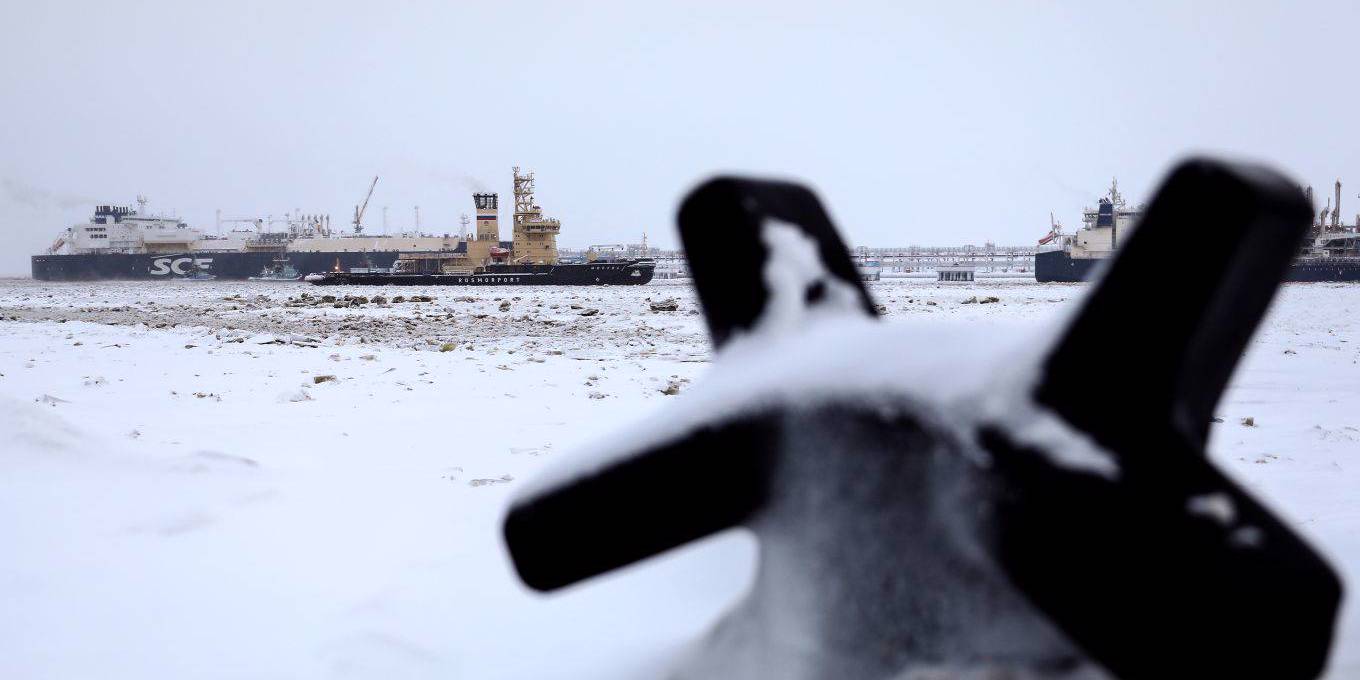
The more that global warming reduces the ice cover in the Arctic, the greater the need there will be for multilateral arrangements to govern trade, resource extraction, and other issues across the region. Without forward-looking cooperation, a zero-sum scramble will ensue, leaving everyone worse off.
Stockholm – Whether we are heading for a future of cooperation or of increasing confrontation in the Arctic remains to be seen. But it is already clear that the region will command far more attention than it has in the past.
The main reason is of course climate change, which is accelerating the rate of ice melt and causing arctic temperatures to rise twice as fast as the global average. Owing to their pace and scale, these changes have obvious geographic, economic, and strategic implications. As the vast ice sheet that spans the region has melted, new fossil-fuel reserves and shipping routes have opened up, including the Northern Sea Route (NSR) along Russia’s Siberian coast and the Northwest Passage through Canada’s northern archipelago. However, the same trend has also fueled the loss of permafrost, threatening billions of dollars’ worth of infrastructure that may soon be standing in mud instead of on firm ground.
Moreover, indigenous communities that have lived in the Arctic for millennia are increasingly voicing concerns about the growing threat to their livelihoods. Nearly half of the Arctic’s land area is in Russia, as are around 70% of the four million people who live in the region. Most live in the Kola Peninsula area near Norway and Finland, which is also home to Russia’s Northern Fleet and most of its sea-based nuclear deterrent. But other parts of the region are no less important, strategically and demographically. Approximately two-thirds of the inhabitants of Canada’s arctic areas are indigenous people, as are the vast majority of the 56,000 people living on Greenland (which itself is the size of a small continent).
This summer, a century-old sailing ship, the Sedov, traversed the NSR without seeing any ice at all. Such journeys still are possible only during the warmest months, whereas transit throughout the rest of the year requires special ships, often escorted by powerful icebreakers. Nonetheless, the sea traffic has been steadily increasing, driven so far by the large energy projects that Russia is developing in Siberia. Chinese and French companies each have a 20% stake in liquid natural gas extraction from the Russian-controlled Yamal gas fields, and South Korean-built tankers are shipping this LNG to Europe – and soon will be supplying East Asia. Needless to say, many more projects are in the works.
Since 1996, the eight arctic countries – Russia, Norway, Finland, Sweden, Denmark (Greenland), Iceland, Canada, and the United States – have cooperated through the Arctic Council, mostly to address environmental issues. But now that the Arctic is becoming an increasingly important global theater, other countries are taking an interest.
In 2013, China, India, Singapore, South Korea, and Japan were granted observer status within the Council, in recognition of their scientific research commitments and interest in future shipping opportunities. The potential for trade could be massive: the arctic sea route from Yokohama, Japan, to Hamburg, Germany, is 40% shorter than the current one that runs through the Suez Canal.
Perhaps inevitably, the new climate of great-power competition has increasingly affected Arctic issues. At the Council’s ministerial meeting in Rovaniemi, Finland, last year, US Secretary of State Mike Pompeo shocked everyone when he refused to agree to a final communiqué and work program that mentioned climate change. The Trump administration instead used the occasion to attack China for its own designs on the region.
In May next year, Iceland will pass the Council’s biennial rotating chairmanship to Russia, which is not likely to squander its two years in the driver’s seat. Over the past decade, the Kremlin has devoted significant resources to strengthening its Arctic positions, reviving defunct Soviet military facilities and building new ones. This military build-up has set off alarms within NATO, even though a sober analysis would find that in most cases, such facilities pose no particular threat to anyone – except, perhaps, polar bears.
Still, other points of contention do matter. Russia regulates all of the shipping through the NSR, and thus will enjoy outsize control for as long as other parts of the Arctic remain covered with ice. But as more ice melts, new shipping channels will open up well north of Russia’s jurisdiction, and this will introduce a slew of new legal issues.Sign up for our weekly newsletter, PS on Sunday
In light of these looming issues, a recurrence of the type of confrontation that derailed the Rovaniemi summit would be most unfortunate. With the executive meeting of the Arctic Council taking place in Reykjavik next month, we will soon know what the future holds.
There are more than enough issues for the US, Russia, China, and others to clash over nowadays. But all should recognize a shared interest in preserving and further developing an open, collaborative framework for the world’s northernmost region. One way or another, the Arctic will become an increasingly important theater. It behooves us all to make it one of mutually beneficial cooperation, not war.
Protect Indigenous People’s rights to avoid a sixth extinction (commentary)
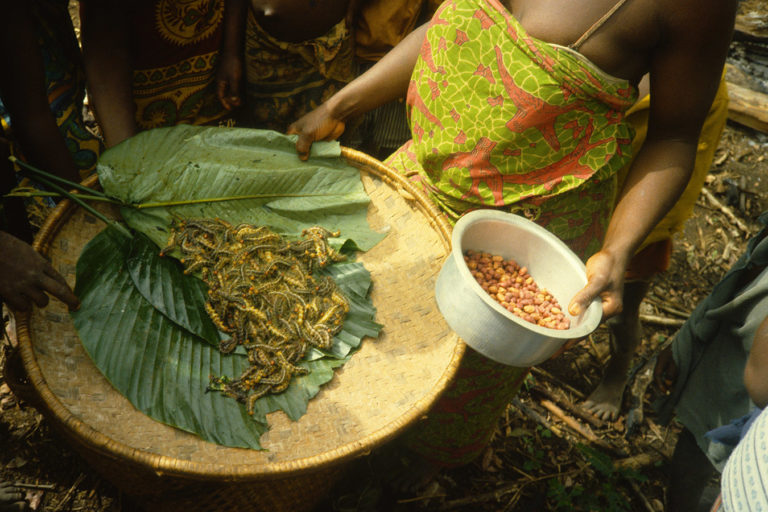
- In this commentary, David Wilkie, Susan Lieberman, and James Watson from the Wildlife Conservation Society (WCS) argue that protecting Indigenous Peoples’ traditional land rights is one of the most effective strategies for preventing the Sixth Mass Extinction.
- “Most of humanity have been grossly negligent in our use of the Earth,” they write. “Wise stewardship of natural resources by Indigenous Peoples within their traditional territories has had a profoundly positive impact on the conservation of plant and animal species on land and in rivers, lakes, and coastal waters.”
- “The decisions Indigenous Peoples have made over generations have done more to protect the planet’s species and ecological systems than all the protected areas established and managed by individual countries combined. The majority of our planet’s last wild, ecologically intact places on land exist because Indigenous Peoples rely on them for their wellbeing and cultural sense of self.”
- This post is a commentary. The views expressed are those of the author, not necessarily Mongabay.
Humanity today face multiple crises. A pandemic grips societies around the globe and with each passing year greed, poor governance, and naivete push us further toward a climate change forced sixth great extinction and the collapse of ecosystems. It may already be too late to prevent the looming catastrophe of climate change. But there is an overlooked and undervalued blueprint for our survival. We must turn for help to the Indigenous Peoples who have, for millennia, provided effective stewardship of our planet.
Most of humanity have been grossly negligent in our use of the Earth. Businesses run according to self-interest have ignored the warnings of scientists to the detriment of a global community of bystanders. Governments have failed to attend to the long-term environmental and climate effects of those actions through necessary regulation and enforcement. And urban individuals and families continue to make choices with little if any understanding of how their consumption impacts the planet and our future on it.
Our planet has experienced five previous extinction events—the most recent responsible for the disappearance of the dinosaurs. If we are to minimize the impact of growing threats to the ecological systems essential to human life and prevent the planet’s sixth mass extinction, we need to protect the last remaining areas on earth that are relatively intact.
When we say “intact” we mean those dwindling places that still retain almost complete assemblages of native plants and animals, and where species are still interacting at ecologically functional population levels. Intact places resist climate change because they have multiple, redundant networks for capturing, using, and reusing energy. They better conserve plant and animal species and their complex ecological interactions, than degraded areas, when impacted by floods, fires and droughts. They sequester massive amounts of carbon and they keep wildlife pathogens out of reach of humans for whom they pose a deadly threat.

The current health, economic and environmental crises are shifting public opinion around the world about our role in damaging our Planet. Today there is a growing willingness to take decisive actions that are vital for humanity’s future.
Effectively and equitably protecting at least 30 percent of the world on land and sea by 2030, is one such way forward. But we need to be very clear that attaining this goal of “30 by 30” cannot happen unless governments, businesses, grant makers, and civil society respect and protect the territorial rights and traditional stewardship of Indigenous Peoples.
Wise stewardship of natural resources by Indigenous Peoples within their traditional territories has had a profoundly positive impact on the conservation of plant and animal species on land and in rivers, lakes, and coastal waters.
The decisions Indigenous Peoples have made over generations have done more to protect the planet’s species and ecological systems than all the protected areas established and managed by individual countries combined. The majority of our planet’s last wild, ecologically intact places on land exist because Indigenous Peoples rely on them for their wellbeing and cultural sense of self.

John Fa and his colleagues have estimated that 36 percent of ecologically intact forests lie within Indigenous Peoples’ territories. And Stephen Garnett and his colleagues note that though Indigenous Peoples represent less than 5 percent of the human population on earth, they currently manage or have rights over “many of the world’s most sparsely populated, intact places.” And just last week, Chris O’Bryan and his colleagues showed that 646 mammal species—around 14 per cent of those assessed by the International Union for Conservation of Nature (IUCN)—have more than half of their ranges within these lands.
That said, we know that these preliminary assessments grossly underestimate the extent of Indigenous Peoples’ territories. If you were to map the areas in which the loss of species and ecosystems has not occurred or is minimal, it would align with those last ecologically intact places on earth and the territories of Indigenous Peoples.
If we are to minimize species loss and a collapse in ecosystem function, we must do all we can to support Indigenous Peoples’ rights and their efforts to protect their lands and waters. This means respecting and enforcing their territorial rights and ensuring that they can exercise their legitimate authority to determine who has access to and can use their resources.
International conservation organizations should and do play a role in providing on-the-ground assistance to Indigenous Peoples.
Working respectfully with Indigenous Peoples to support their efforts and hear their concerns is both a moral imperative and one of the most effective pathways to achieve the 30×30 goals, protect and conserve the planet’s biodiversity and ecosystem functions, and ensure a sustainable, healthy, and equitable future for all of humanity.
David Wilkie is Executive Director for Rights + Communities at WCS (Wildlife Conservation Society); Susan Lieberman is Vice President for International Policy at WCS; James Watson directs the Science and Research Initiative at the Wildlife Conservation Society and is a professor of conservation science at the University of Queensland. The Wildlife Conservation Society (WCS) actively engages with 205 groups of Indigenous Peoples in 39 countries around the world to help them protect their lands and waters.